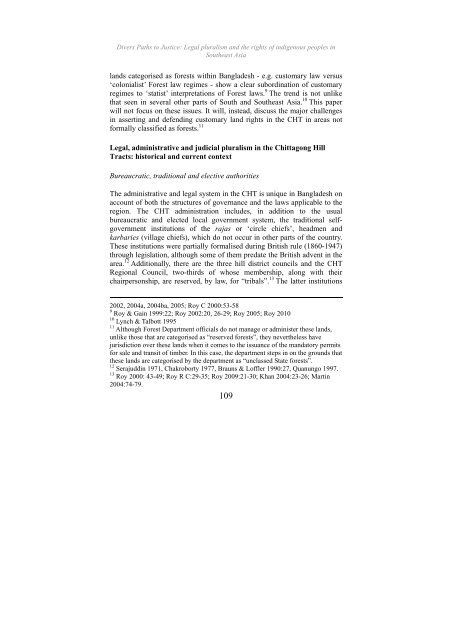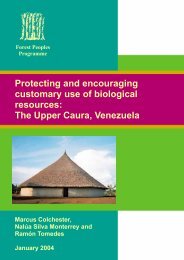Divers Paths to Justice - English - Forest Peoples Programme
Divers Paths to Justice - English - Forest Peoples Programme
Divers Paths to Justice - English - Forest Peoples Programme
Create successful ePaper yourself
Turn your PDF publications into a flip-book with our unique Google optimized e-Paper software.
<strong>Divers</strong> <strong>Paths</strong> <strong>to</strong> <strong>Justice</strong>: Legal pluralism and the rights of indigenous peoples inSoutheast Asialands categorised as forests within Bangladesh - e.g. cus<strong>to</strong>mary law versus‘colonialist’ <strong>Forest</strong> law regimes - show a clear subordination of cus<strong>to</strong>maryregimes <strong>to</strong> ‘statist’ interpretations of <strong>Forest</strong> laws. 9 The trend is not unlikethat seen in several other parts of South and Southeast Asia. 10 This paperwill not focus on these issues. It will, instead, discuss the major challengesin asserting and defending cus<strong>to</strong>mary land rights in the CHT in areas notformally classified as forests. 11Legal, administrative and judicial pluralism in the Chittagong HillTracts: his<strong>to</strong>rical and current contextBureaucratic, traditional and elective authoritiesThe administrative and legal system in the CHT is unique in Bangladesh onaccount of both the structures of governance and the laws applicable <strong>to</strong> theregion. The CHT administration includes, in addition <strong>to</strong> the usualbureaucratic and elected local government system, the traditional selfgovernmentinstitutions of the rajas or ‘circle chiefs’, headmen andkarbaries (village chiefs), which do not occur in other parts of the country.These institutions were partially formalised during British rule (1860-1947)through legislation, although some of them predate the British advent in thearea. 12 Additionally, there are the three hill district councils and the CHTRegional Council, two-thirds of whose membership, along with theirchairpersonship, are reserved, by law, for “tribals”. 13 The latter institutions2002, 2004a, 2004ba, 2005; Roy C 2000:53-589 Roy & Gain 1999:22; Roy 2002:20, 26-29; Roy 2005; Roy 201010 Lynch & Talbott 199511 Although <strong>Forest</strong> Department officials do not manage or administer these lands,unlike those that are categorised as “reserved forests”, they nevertheless havejurisdiction over these lands when it comes <strong>to</strong> the issuance of the manda<strong>to</strong>ry permitsfor sale and transit of timber. In this case, the department steps in on the grounds thatthese lands are categorised by the department as “unclassed State forests”.12 Serajuddin 1971, Chakroborty 1977, Brauns & Loffler 1990:27, Quanungo 1997.13 Roy 2000: 43-49; Roy R C:29-35; Roy 2009:21-30; Khan 2004:23-26; Martin2004:74-79.109
















